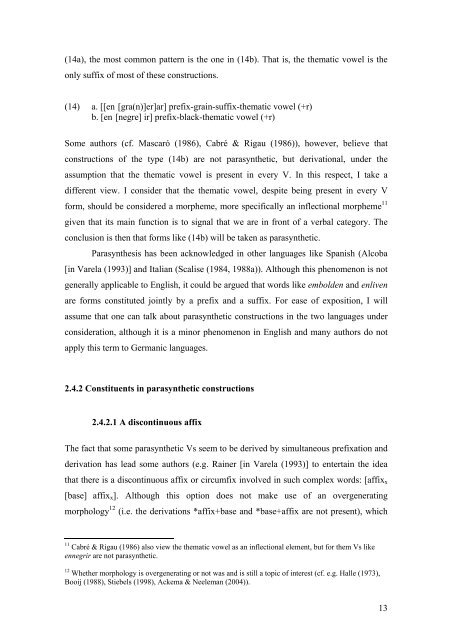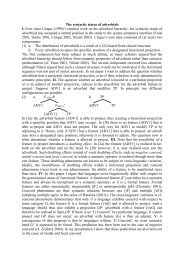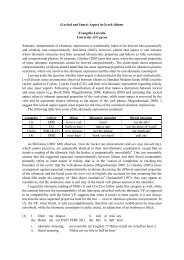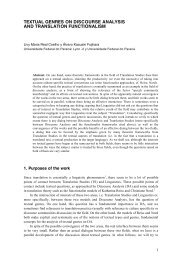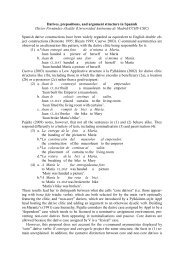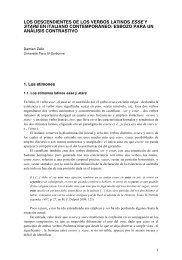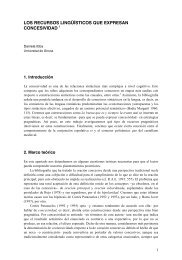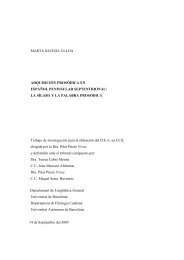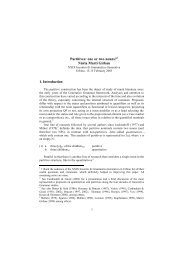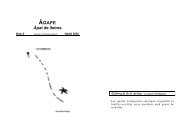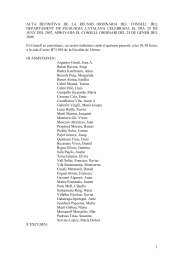Prefixation in English and Catalan - Departament de Filologia ...
Prefixation in English and Catalan - Departament de Filologia ...
Prefixation in English and Catalan - Departament de Filologia ...
Create successful ePaper yourself
Turn your PDF publications into a flip-book with our unique Google optimized e-Paper software.
(14a), the most common pattern is the one <strong>in</strong> (14b). That is, the thematic vowel is the<br />
only suffix of most of these constructions.<br />
(14) a. [[en [gra(n)]er]ar] prefix-gra<strong>in</strong>-suffix-thematic vowel (+r)<br />
b. [en [negre] ir] prefix-black-thematic vowel (+r)<br />
Some authors (cf. Mascaró (1986), Cabré & Rigau (1986)), however, believe that<br />
constructions of the type (14b) are not parasynthetic, but <strong>de</strong>rivational, un<strong>de</strong>r the<br />
assumption that the thematic vowel is present <strong>in</strong> every V. In this respect, I take a<br />
different view. I consi<strong>de</strong>r that the thematic vowel, <strong>de</strong>spite be<strong>in</strong>g present <strong>in</strong> every V<br />
form, should be consi<strong>de</strong>red a morpheme, more specifically an <strong>in</strong>flectional morpheme 11<br />
given that its ma<strong>in</strong> function is to signal that we are <strong>in</strong> front of a verbal category. The<br />
conclusion is then that forms like (14b) will be taken as parasynthetic.<br />
Parasynthesis has been acknowledged <strong>in</strong> other languages like Spanish (Alcoba<br />
[<strong>in</strong> Varela (1993)] <strong>and</strong> Italian (Scalise (1984, 1988a)). Although this phenomenon is not<br />
generally applicable to <strong>English</strong>, it could be argued that words like embol<strong>de</strong>n <strong>and</strong> enliven<br />
are forms constituted jo<strong>in</strong>tly by a prefix <strong>and</strong> a suffix. For ease of exposition, I will<br />
assume that one can talk about parasynthetic constructions <strong>in</strong> the two languages un<strong>de</strong>r<br />
consi<strong>de</strong>ration, although it is a m<strong>in</strong>or phenomenon <strong>in</strong> <strong>English</strong> <strong>and</strong> many authors do not<br />
apply this term to Germanic languages.<br />
2.4.2 Constituents <strong>in</strong> parasynthetic constructions<br />
2.4.2.1 A discont<strong>in</strong>uous affix<br />
The fact that some parasynthetic Vs seem to be <strong>de</strong>rived by simultaneous prefixation <strong>and</strong><br />
<strong>de</strong>rivation has lead some authors (e.g. Ra<strong>in</strong>er [<strong>in</strong> Varela (1993)] to enterta<strong>in</strong> the i<strong>de</strong>a<br />
that there is a discont<strong>in</strong>uous affix or circumfix <strong>in</strong>volved <strong>in</strong> such complex words: [affixx<br />
[base] affixx]. Although this option does not make use of an overgenerat<strong>in</strong>g<br />
morphology 12 (i.e. the <strong>de</strong>rivations *affix+base <strong>and</strong> *base+affix are not present), which<br />
11<br />
Cabré & Rigau (1986) also view the thematic vowel as an <strong>in</strong>flectional element, but for them Vs like<br />
ennegrir are not parasynthetic.<br />
12 Whether morphology is overgenerat<strong>in</strong>g or not was <strong>and</strong> is still a topic of <strong>in</strong>terest (cf. e.g. Halle (1973),<br />
Booij (1988), Stiebels (1998), Ackema & Neeleman (2004)).<br />
13


